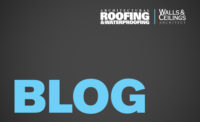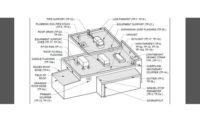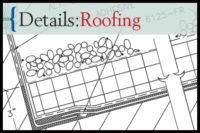Details: Roofing
The
installation of two layers of insulation provides many advantages for all types
of conventional low-slope membrane systems.

The installation of two layers of insulation provides many advantages for all types of conventional low-slope membrane systems. The primary advantage of double-layered insulation is that it provides a smoother top surface for the application of the membrane. Single-layered insulation often conforms to irregularities in the substrate, creating an uneven, warped surface. Studies have indicated that warping of insulation is reduced in double-layered applications because proper adhesion between insulation boards is easier to achieve than it is between the insulation and substrate. This is also true because the joints of the top layer of insulation are offset from the joints of the bottom layer to form an almost continuous plane. This is an important characteristic in adhered membrane systems because membrane adhesion is more successful over flat, stable surfaces.
Double-layered insulation is also preferable over metal decks, which account for the majority of roof substrates in the United States commercial roofing market. Applying a cover board over mechanically attached insulation offers three distinct advantages. The first advantage is that it reduces the shank length of the fastener by as much as one-half of the total insulation thickness. The fastener is only required to penetrate through the bottom layer of the insulation. The cover board is adhered using hot asphalt or a specially formulated adhesive that is applied over the top surface of the bottom layer of insulation.
The cover board also serves to insulate the fastener, eliminating energy loss and possible thermal bridging at fasteners and insulation joints. Thermal bridging contributes to condensation, which could occur where sub-freezing outdoor temperatures are met with rising heat circulated from the warmer interior spaces. Offsetting insulation joints between the two layers of insulation blocks vertical paths of upward-moving water vapor that could condense at the cold side of the membrane and contribute to the formation of membrane ridges.
Some manufacturers require that the joints of the cover boards are stripped in to eliminate the possibility of moisture entry into the system.
 Materials
Materials

The installation of two layers of insulation provides many advantages for all types of conventional low-slope membrane systems. The primary advantage of double-layered insulation is that it provides a smoother top surface for the application of the membrane. Single-layered insulation often conforms to irregularities in the substrate, creating an uneven, warped surface. Studies have indicated that warping of insulation is reduced in double-layered applications because proper adhesion between insulation boards is easier to achieve than it is between the insulation and substrate. This is also true because the joints of the top layer of insulation are offset from the joints of the bottom layer to form an almost continuous plane. This is an important characteristic in adhered membrane systems because membrane adhesion is more successful over flat, stable surfaces.
Double-layered insulation is also preferable over metal decks, which account for the majority of roof substrates in the United States commercial roofing market. Applying a cover board over mechanically attached insulation offers three distinct advantages. The first advantage is that it reduces the shank length of the fastener by as much as one-half of the total insulation thickness. The fastener is only required to penetrate through the bottom layer of the insulation. The cover board is adhered using hot asphalt or a specially formulated adhesive that is applied over the top surface of the bottom layer of insulation.
The cover board also serves to insulate the fastener, eliminating energy loss and possible thermal bridging at fasteners and insulation joints. Thermal bridging contributes to condensation, which could occur where sub-freezing outdoor temperatures are met with rising heat circulated from the warmer interior spaces. Offsetting insulation joints between the two layers of insulation blocks vertical paths of upward-moving water vapor that could condense at the cold side of the membrane and contribute to the formation of membrane ridges.
Some manufacturers require that the joints of the cover boards are stripped in to eliminate the possibility of moisture entry into the system.

Cover board stripping-in detail courtesy of Kemper System.
- Urethane sealant
- Fleece material (as required by roofing system manufacturer)
- Primer or bonding adhesive
- Apply urethane sealant into cover board joints that exceed 1/8 of an inch in width.
- Set manufacturer-approved fleece material in an approved primer or bonding adhesive over all cover board joints. The material shall be applied for even coverage at both sides of the joint.
- Apply the bonding resin over the completed membrane surface. The resin shall be applied in a full and even application in accordance with the manufacturer’s requirements.
- Prior to full cure of the bonding resin, broadcast the approved aggregate surfacing over the entire area. Make certain that there is even coverage throughout the area.
- Apply the manufacturer’s approved sealing resin over the completed aggregate surface.
- Application must be in compliance with the manufacturer’s requirements and completed at approved ambient temperatures.
Looking for a reprint of this article?
From high-res PDFs to custom plaques, order your copy today!





